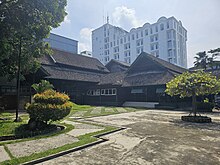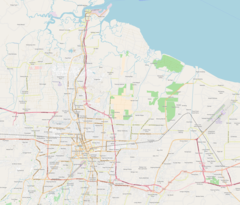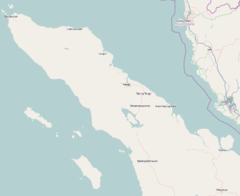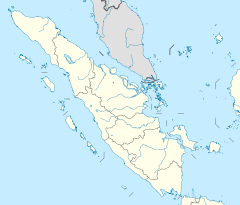Hirohara Jinja (紘原神社, Hirohara Jinja, lit. "Hirohara Shrine") is a former Shinto shrine located in Medan, Indonesia. The shrine was built in 1944 by the 2nd Guards Division of the former Imperial Japanese Army.[4][1] It is situated slightly inland from the North Sumatra Governor’s Office, formerly known as the East Coast Provincial Office during the Japanese occupation of Indonesia.
| Hirohara Jinja Hirohara Shrine 紘原神社 | |
|---|---|
 Hirohara shrine in 2024 | |
| Religion | |
| Affiliation | Shinto |
| Sect | Jingūkyō[1] |
| Deity | Amaterasu[1][2] |
| Festival | Taishohou Taibi (大詔奉戴日) (8th of every month) |
| Year consecrated | August 11, 1944[1] |
| Location | |
| Location | Jalan R.A. Kartini No.36, Madras Hulu, Medan Polonia, Medan, North Sumatera, Indonesia |
| Geographic coordinates | 3°34′49.674″N 98°40′15.9312″E / 3.58046500°N 98.671092000°E |
| Architecture | |
| Date established | 1905[3][a] |
| Groundbreaking | 1 April 1943 |
| Completed | 4 July 1944[1] |
| Site area | 148.500 m² |
| |
The shrine is believed to be the last remaining surviving shrine building among those built by the former Japanese Imperial Army in various parts of the Greater East Asia Co-prosperity Sphere and, likely, the last Shinto shrine building in Southeast Asia.[5][4] The shrine remained after the war and is now used as a meeting place for the local rich as the 'Medan Club'. The building was designated as a heritage site and protected by the Medan city Government,[3] though the future of the site is uncertain.
Name
editThe 'Hiro' (紘) in Hirohara was taken from the Greater East Asia War principle 'Hakkō ichiu' (八紘一宇), and the 'Hara' (原) was named after the Indonesian word 'Medan' (field).[1][6] Another possible meaning of "Hiro" is wide or expansive.[2]
History
editMedan had a sparse population nor had a rapid development until the middle of the Meiji era, when the Dutch rulers began to release land for tobacco plantations. This shift in land use facilitated Medan's evolution into a prominent trading hub, subsequently elevating its status to a governmental center. Soon word began to spread over the burgeoning prosperity of the city, attracting a wave of migrant laborers, notably from the Japanese community. Due to this, Medan has been a center of Japanese migration to Indonesia outside of Batavia.[6] Dutch consulate reports indicate that there were 782 registered Japanese migrants in Batavia in 1909 (with an estimated 400 more yet to register), and an additional 278 (comprising 57 men and 221 women) in Medan by 1910.[7] Renowned poet Mitsuharu Kaneko, once also stayed at an inn in Medan's Indian quarter, Kampung Keling, during his travels to the Dutch East Indies in the early Showa period. Stating that there were more than 40 Japanese-run inns in the new town alone.[8] Japanese laborers then became entrepreneurs, some even plantation owners themselves.
According to local accounts in Medan, preceding the establishment of the Hirohara Shrine at its current site, there existed a precursor Japanese shrine. Historian, Ichwan Azhari, explained that due to the influx of Japanese laborers to Medan, who were at the time recorded majority as adhering to Japanese Buddhism, it necessitated a designated place of worship for the growing community. Thus leading to the creation of the first iteration of the shrine.[3] According to the last head of the Medan Club, Eswin Soekardja, the shrine was made after when Japanese laborers entered and settled in Medan.[9]
Japanese invasion
editAfter the Fall of Singapore and the Invasion of Sumatra, on 1 June 1943, the 2nd Guards Division made the Medan area of Sumatra, Dutch East Indies (present-day Indonesia) as their base of operations in Southeast Asia.[10] During the war, shrines were erected across occupied territories as places of prayer for victory and enhanced morale, in Indonesia alone there were 11 shrines.[11] Following this, Mutō then initiated the construction of a shrine of his own on the land.[4] According to Prof. Nakajima Michio (Former Rector of Kanagawa University), the building was designed by Suzuki Hiroyuki, an architect from Japan's Home Ministry. The construction of Hirohara Shrine was ordered by the Japanese army, in co-operation with the Japanese private sector.[2] It is said that the that the wood used for the shrine was a “sacred tree” from deep within the Aceh mountains, supplied by the Showa Rubber branch in Medan during the military occupation, and that Dutch prisoners of war and Rōmusha's were employed in its construction, making it possibly the only shrine built by Christians.[12] One of them was Dutch writer, Willem Brandt. In his work, De gele terreur in 1946, he once described the condition:[13][14]
"... hasn't Sumatra become part of Japan? The avenues and streets are given unpronounceable Japanese names. Prisoners of war were put to work in the experimental garden of the Deli Experimental Station to dig a lotos pond and build a Japanese park with terraces and temples."
During the war, ceremonies were held at the Hirohara Shrine on the 1st and 15th of every month, with the 8th day designated for the Great Ceremony (Japanese: 大詔奉戴日, romanized: Taishohou Taibi.) Military personnel would visit to pray for victory, subsequently worshipping the Miyagi Yohai (Japanese: 宮城遥拝), a practice of bowing to the general direction of the Japanese imperial family (Miyagi) from afar.[12] This practice seemed peculiar to the predominantly Muslim population of Medan, who pray towards Mecca five times daily. During the occupation, some Japanese soldiers compelled residents, even foreigners in POW camps, to worship the Japanese imperial family from a distance, causing friction as doing Miyagi Yohai is eastward, the exact opposite direction of Mecca in the west.[12][15] Although the basics of Islam were initially taught to the top executives of Japan’s military government, this education was not thoroughly implemented, leading to issues. Shizuo Saito, a former ambassador to Indonesia and Australia[16] and a military administrator for the former Japanese Army during the war, wrote in his book that he "institutionalized hair cutting'' and "forced Japanese language,'' as well as "forced worship from a distance in Miyagi.'' He stated that the locals were encouraged to visit the shrine and that he made them worship.[15] Despite the destruction of these shrines by the Japanese army and locals at the end of the war, the Hirohara Shrine inexplicably remained intact. Given the limited construction during the three-year Japanese occupation of Indonesia, the Hirohara Shrine is considered a significant historical structure.[4]
Medan club
editIn the aftermath of Japan's surrender, an attempt was made to dismantle the shrine from 26 August to 31 August 1945 under the orders from the Home Ministry, as to avoid the desecration of the shrine. The dismantling of the shrine was underway when it was supervised by Suzuki Hiroyuki himself, who stayed in Medan along the course of the war.[2] Both the honden and haiden, and other small shrines on the site, were successfully dismantled. The process was abruptly ended when British forces immediately began landing at Belawan in 9 October and blitzed their way to the city of Medan,[17] facing little to no resistance and denying any movement for the Japanese to properly undertake any decisive actions.[18] As a result, most infrastructure and buildings in Medan, including the shamusho, remained relatively intact. In the next year, Suzuki Hiroyuki went back to Japan.[2] During the occupation of the city of Medan by the Allies, the building was repurposed as a Dutch white supremacist clubhouse known as De Witte Sociëteit (English: The White Society.)[19][20] De Witte Sociëteit was established in 1879, serving as a gathering place for the white, Dutch Totoks, Chinese, high-ranking land owners of Deli, and the Sultan of Deli himself;[19] no Inlander and dogs would be allowed in.[20] Their first clubhouse was located adjacent to the main post office of Medan (now the Bank BCA). The Club House was initially conceived as a convivial space for Dutch plantation owners where they could assemble for recreational activities. This encompassed partaking in beverages such as coffee, engaging in smoking, and participating in discussions from literature and business to politics, art, and culture.[21]
Following the departure of the Dutch from Indonesia, former military members Dr. Soekarja, Dr. Hariono, and Dr. Ibrahim Irsan took over this clubhouse building and renamed it "Medan Club". The Medan Club was an exclusive establishment for the upper echelons of Medan society. Membership is required to access the Medan Club’s facilities.[19] Medan Club foundation, a foundation formerly owned by 150-200 members, that runs the operation, administration and upkeep of the former shrine, claims financial difficulties,[19] with income derived only from monthly member fees and high operational costs. This led the delinquent absence in paying property tax since 2009, with a total debt of Rp.964,154,774, including late payment fines. The Medan Revenue Service has sent four tax invoices since 2013 and had plans to issue another one later.[22]
Amids financial difficulties, in 2018, the owners of the Medan Club opened the Medan Club to the public and turned the Medan club from an exclusive members only club into a high-end restaurant and meeting venue.[23][5] Using this option, on August 6, 2018, a seminar was held by the Consulate-General of Japan in Medan at the Medan Club, featuring various dignitaries as speakers to commemorate 60 years of diplomatic relations between Japan and Indonesia,. The celebration included cultural promotions such as Shodō, Sadō, Furoshiki Wrapping, as well as performance arts such as Yosakoi dance and karate.[24][25]
A year later, the owners then intended to retool the club into a 'night life' entertainment club. The sudden retooling brought scrutiny as the Medan club has not obtained the necessary business license for operating as a night entertainment venue and was only permitted under a restaurant license.[23] Amidst financial difficulties and the high cost of maintaining the shrine building, the Club find itself at the brink of bankruptcy.
Possible demolition
editOn 28 October 2021, the former shrine was officially designated as a cultural heritage site by the Medan City Government. This recognition was based on Medan City Government Decree (SK) number 433 of 2021, issued by Mayor Bobby Nasution.[3] Unexpectedly on 9 July, the provincial government bars the selling of the land to any third party other than the provincial government themselves. Then governor of North Sumatra, Edy Rahmayadi, revealed the plan of the North Sumatra Provincial Government to buy Medan Club. Deeming it necessary to develop the land and expand office facilities for the benefit of local government and the community.[26][27] Though a spokesperson vaguely stated that the purchase of the Medan Club won't necessarily result in "its disappearance," intending to buy other plots near the building to replace it.[28] The land was agreed to be bought for over Rp.457 billion (or $28,567,070.00 in USD) and has been estimated in the 2022 North Sumatran Regional Revenue and Expenditure Budget (APBD) amounting to Rp.300 billion and the rest Rp.157 billion more, estimated in the 2023 North Sumatran APBD.[29] The purchase brought in criticism, starting from the urgency for the benefit of the people of North Sumatra, to the price.[30] Edy spoke up to this criticism by saying that had the land was not purchased, the Medan Club's land could have been rebuilt as a hotel, apartment or plaza. He further argued, "Imagine a building that could be 50 floors high while the government building is only 10 floors; imagine that."[31][32] He also planned to purchase an old house beside the former shrine.[31] The purchasing mechanism was also said to be violating the rules as the Shrine was built on the lands owned by the Sultanate of Deli,[33] who was thought to have never been compensated. The Suka Piring Administration and those representing the heirs of the Sultan of Deli sued the Medan Club Association Management for more than IDR 442.9 billion at the Medan District Court (PN). Akhmad Syamrah, a spokes person for the Suka Piring, claimed that the land that would be used for the expansion of the North Sumatra Governor's Office still belongs to the Deli indigenous community, as it was formerly given to the Medan Deli Maatschappij as a Concession by the sultanate. Based on Law No. 86 of 1958, all land and buildings that were once controlled and operated by the Dutch were then nationalized by the Indonesian Government and declared to be state property. However it is uncertain whether the Medan Club takeover from the De Witte Sociëteit was the result of nationalization or a takeover.[34][35] After time, the issue was deemed to be legal after a ruling by the North Sumatra High Prosecutor's Office.[36]
On 16 January 2023, the barrier between the former shrine and the provincial office has been destroyed,[37] intending to use the land for parking space and local social activities for the time being.[38][39] In the aftermath of the destroyed barrier, the legality of the demolition is in question, whether the provincial government could destroy a cultural heritage site given its heritage status. Isnen Fitri, a professor to the University of North Sumatra, gives a neutral perspective on the purchase. She believes that buildings such as the shamusho and cities are dynamic and not static and thus, methods like allowing changes in ownership and function are vital to accommodating and ensuring that historic buildings remain visible today. Though nether at a point of total conservation or destruction.[2] Ichwan Azhari believes that the Cultural Heritage Law could be violated but the law states that one is not allowed to damage or replace anything in the building, including the building itself and its surrounding environment.[3] Meanwhile, plans are underway to construct a multi-purpose building on this site, serving as a hub for public services, permits, and other administrative functions. The Detailed Engineering Design (DED) for the building is currently being prepared, with an estimated budget of around Rp500 million. The future of the former shrine is uncertain, with its complete demolition being a possibility.[38] The North Sumatra Provincial Government is currently lobbying for the Perindo Party's building, located right next to the Medan Club, to sell its land.[40] As the area including the shrine itself was designated as an office zone and the maximum building height for the area being 13 floors according to the City Regional Regulation No. 2/2015 on the Detailed Spatial Plan (RDTR) and Zoning Regulations of Medan City 2015-2035.[33][36]
Structure
editThe club’s premises, which likely encompass the site of the old main shrine, feature Western-style partitioned rooms where members can eat local and western foods. Although the torii gate has been removed, careful observation reveals remnants of its past shrine aesthetics. Several ancient trees, believed to have been part of the original temple grounds, still stand on the property.[12][5] According to Eswin Soekardja, the land encompassing the building used to be as large as 1.5 hectares (now 1.4 hectares),[9][28] including a golf course that may have previously been the shrine's garden,[9] extending to the Deli River.[2][9] The shamusho (社務所, shrine office), still remains the same, albeit partially altered.[1] Noticeably the flooring of the shrine; now ceramic tiling rather than wood paneling for the earthen floor.[5] It is thought that the shrine does not have a Honden (本殿, main hall)[1] Though this might be the fact that it was destroyed by later redevelopments in the area. The shrine used to formerly have an Ottori and a pond across the street to what is now an intersection.[2]
The exact main purpose of the shrine remains unclear, as the honden (and possibly the haiden) were destroyed and very little information exists. Researchers from the University of Kanagawa who visited the site initially hypothesized that the shrine was used to honor the war dead, known as a Gokoku shrine (formerly Shokonsha). Though it might as well suggest that the honden enshrines Amaterasu Ōmikami, the Sun Goddess and highest deity in Shinto, making it a shinmei shrine.[1] And that the Haiden (拝殿, worship hall) was used to pray for the welfare of the Japanese and Indonesian people. Though to Ito Masatoshi of Nihon University, such shrines would not be created for the benefit and welfare of the locals but rather for political reasons as praying towards Amaterasu held the same footing as praying to the Emperor at that time.[2]
Once infamous Dutch poet and writer, Rudy Kousbroek, visited the former shrine during his work for NRC Handelsblad in the 1980s. He described the former shrine as "possessing the sophistication of simplicity, modesty, and silence. Its unadorned surfaces, natural proportions, and raw wood evoked an aesthetic that had been cultivated over a thousand years, devoid of any display of power, ostentation, or vulgarity."[14] Later stating on his first visit:
"Here in Sumatra, I stared at it in amazement: it was the first time I saw two worlds coincide, worlds that are better kept separate for one's peace of mind. It reminded me of the Japanese I encountered during the war. They must have looked at this, at that wooden veranda, those red lacquered stairs. They must have celebrated their victories here, sat on this plank floor, and perhaps even enjoyed it. This time, it's not different people, but the same ones. The same individuals who built the Pakanbaroe railway also built this hall. By the same prisoners of war."[14]
Gallery
edit-
Wedding ceremony group photo. Front row, second from left, the mediator, Lieutenant General Tetsuzo Nakajima and to his right, Itoko Koyama, who was in Medan as a military writer (April 7, 1944.)[1]
-
Same view, now a parking lot with remnants visible, the same trees untouched, and tree line preserved
-
Hirohara Jinja, second building
-
Sideview of the Shamusho. Terrace mounds still visible
-
Shamusho front balcony
-
Medan Club entrance
-
Entrance roofing. Notice the usage of straw roofing (Kayabuki)
-
Interior of the shamusho
-
Interior of the hall (back)
-
Interior of the hall (front)
-
Shamusho backside. Wooden railings on what was formerly a balcony still visible
References
edit- ^ a b c d e f g h i j 中島, 三千男; 津田, 良樹; 稲宮, 康人 (2019-03-20). "旧オランダ領東印度(現インドネシア共和国)に建てられた神社について" [On shrines built in the former Dutch East Indies (now Republic of Indonesia)]. 非文字資料研究センター News Letter (in Japanese) (41): 17–23. ISSN 2432-549X.
- ^ a b c d e f g h i Fitri, Isnen; Saidin, OK. & ITO, Masatoshi (2023-05-13). "Lecture: Tranformasi Peralihan Fungsi Gedung Medan Club Dari Tahun 1879-sekarang" (Lecture) (in Indonesian and Japanese). Jurusan Pendidikan Sejarah Universitas Negeri Medan. Retrieved 2024-05-28 – via YouTube.
- ^ a b c d e "Dibeli Pemprov Sumut, Medan Club Sudah Ditetapkan Sebagai Cagar Budaya oleh Pemko Medan". Tribun-medan.com (in Indonesian). Retrieved 2024-04-17.
- ^ a b c d "スマトラ.メダンにある日本の歴史遺産 紘原神社 - 「老人タイムス」私説". goo blog (in Japanese). Retrieved 2024-04-17.
- ^ a b c d e Inamiya, Yasuhito; Nakajima, Michio (November 2019). 非文字資料研究叢書2 「神国」の残影|国書刊行会 [Remnants of “Sacred Country” | Photographic Records of Sites of Overseas Shrines] (in Japanese). Kokusho Publishing Association. ISBN 978-4-336-06342-7. Archived from the original on 2023-08-01. Retrieved 2023-08-01.
- ^ a b "コタ.コタ インドネシア(6)メダン 神社転じてクラブ - 「老人タイムス」私説". goo blog (in Japanese). Retrieved 2024-05-01.
- ^ Murayama, Yoshitada (2018-12-31), Shiraishi, Takashi; Shiraishi, Saya S. (eds.), "4. The Pattern Of Japanese Economic Penetration Of The Prewar Netherlands East Indies", The Japanese in Colonial Southeast Asia, Ithaca, NY: Cornell University Press, pp. 89–112, doi:10.7591/9781501718939-005, ISBN 978-1-5017-1893-9, retrieved 2024-05-01
- ^ Kaneko, Mitsuharu (2004). マレー蘭印紀行 [Malay Orchid Travelogue] (in Japanese) (revised Chuko Bunko ed.).
- ^ a b c d NgeHank - Bangunan Tertua Di Medan, Medan Club. Waspada.Id. Retrieved 2024-05-01 – via www.youtube.com.
- ^ 武藤章 (2008-12-20). 『比島から巣鴨へ 日本軍部の歩んだ道と一軍人の運命』. 中公文庫. p. 80.
{{cite book}}: CS1 maint: date and year (link) - ^ Dendy (2017-03-17). "Malang Gudang Sejarah Belanda dan Jepang". Jurnalis Malang. Retrieved 2023-08-01.
- ^ a b c d "『 紘原(ひろはら)神社』". 1000都物語 (in Japanese). Retrieved 2024-04-17.
- ^ Klooster, Willem Simon Brand (1946). De gele terreur (1st ed.). Den Haag: W. van Hoeve. LCCN 54016641. OCLC 23409584. OL 6159577M.
- ^ a b c Kousbroek, Rudy (1980-08-01). "Duizend Jaar Nadenken". NRC Handelsblad. p. 15 – via delpher.nl.
- ^ a b Saito, Shizuo (1 March 1977). 私の軍政記 : インドネシア独立前夜. Japan Indonesia Association. OCLC 673871439.
- ^ "Japanese envoy named". The Canberra Times (ACT : 1926 - 1995). ACT: National Library of Australia. 6 December 1969. p. 3. Retrieved 21 January 2016.
- ^ Reid, Anthony (2014). The blood of the people: revolution and the end of traditional rule in northern Sumatra (Second ed.). Singapore: NUS Press. pp. 158–159. ISBN 978-9971-69-637-5.
- ^ Raliby, Osman (1953). Documenta historica: sedjarah dokumenter dari pertumbuhan dan perdjuangan negara Republik Indonesia (in Indonesian). Djakarta: Bulan-Bintang. p. 52. LCCN 56033758. OCLC 11928099. OL 6209293M.
- ^ a b c d "Pembelian Medan Club: "Lemahnya Dinas Kominfo Sumut"". AgioDeli.id (in Indonesian). Retrieved 2024-04-16.
- ^ a b "White Society". Stories from Deli. 2020-09-30. Retrieved 2024-04-16.
- ^ "1879 Club house of the Witte Societeit, Medan". 1879 Club house of the Witte Societeit, Medan ~ Tembakau Deli. 22 March 2013. Retrieved 2024-04-17.
- ^ Redaksi. "Medan Club Tunggak PBB 6 Tahun - Sumut Pos". Medan Club Tunggak PBB 6 Tahun - Sumut Pos (in Indonesian). Retrieved 2024-04-17.
- ^ a b Redaksi. "Pembangunan Tempat Hiburan Malam di Medan Club, IMB dan Peruntukannya sebagai Restoran - Sumut Pos". Pembangunan Tempat Hiburan Malam di Medan Club, IMB dan Peruntukannya sebagai Restoran - Sumut Pos (in Indonesian). Retrieved 2024-04-17.
- ^ "Acara Peringatan 60 Tahun Hubungan Diplomatik Jepang – Indonesia". Konsulat Jenderal Jepang di Medan. 6 August 2018.
- ^ "Promosikan Kebudayaan Jepang pada Warga Medan". Analisadaily.com. Retrieved 2024-04-17.
- ^ Pasaribu, Benny (9 July 2021). "Gubernur Edy Ungkap Rencana Pemprov Sumut Beli Medan Club". Benny Pasaribu - MedanBisnisDaily.com (in Indonesian). Retrieved 2024-04-17.
- ^ Argus, Array A., ed. (10 July 2021). "Lahan Medan Club Mau Dijual, Edy Rahmayadi Sebut Pemprov Sumut yang Harus Beli". Tribun-medan.com (in Indonesian). Retrieved 2024-04-17.
- ^ a b Rachmad, Edy (2021-07-07). "Perluasan Kantor, Pemprovsu Berencana Beli Medan Club". beritasore.co.id (in Indonesian). Retrieved 2024-05-11.
- ^ "Pemprov Sumut Klaim Sudah Beli Lahan Medan Club, Akan Dijadikan Kantor Satu Atap". Tribun-medan.com (in Indonesian). Retrieved 2024-04-17.
- ^ "Pembelian Lahan Medan Club Dinilai Terlalu Mahal, Ini Penjelasan Setdaprovsu - Berita Ter Update Hari Ini" (in Indonesian). 2022-12-23. Retrieved 2024-05-11.
- ^ a b "Beli Medan Club Lalu Digugat Ke Pengadilan Negeri, Gubsu Tak Ambil Pusing". Harian Mistar. 2023-01-24. Retrieved 2024-07-23.
- ^ "Ahli Waris Sultan Deli Gugat Penjualan Medan Club, Gubsu: Biarkan Aja, Suka-suka Dia". Sumut Pos. 23 January 2023.
- ^ a b Gunawan, Indra. "Isu panas pembelian Medan Club, Pemprov Sumut mengaku dapat pendampingan hukum dari Kejaksaan - Sumatera Insider". Sumatera Insider (in Indonesian). Retrieved 2024-04-17.
- ^ Ritonga, Rechtin Hani (23 January 2023). "Digugat ke PN Medan Karena Beli Lahan Medan Club, Gubernur Edy Rahmayadi: Suka-suka Dia - Halaman 2 - Tribun-medan.com". medan.tribunnews.com. Retrieved 2024-07-23.
- ^ Ritonga, Rechtin Hani (23 January 2023). "Gubernur Edy Rahmayadi dan Pengurus Yayasan Medan Club Digugat Kedatukan Suka Piring ke PN Medan". Tribun-medan.com (in Indonesian). Retrieved 2024-07-23.
- ^ a b Lubis, Ahmad Arfah Fansuri. "Pemprov Beli Medan Club Rp 457 M untuk Perluasan Kantor Gubsu". detiksumut (in Indonesian). Retrieved 2024-04-17.
- ^ Simbolon, Radja P. (2023-01-16). "Tembok pembatas Medan Club dirubuhkan usai pelunasan lahan". Topmetro News (in Indonesian). Retrieved 2024-04-17.
- ^ a b Ritonga, Rechtin Hani. "Pemprov Sumut Mulai Gunakan Medan Club". Benny Pasaribu - MedanBisnisDaily.com (in Indonesian). Retrieved 2024-04-17.
- ^ "Bangunan Eks Medan Club, Difungsikan Sementara Kegiatan Sosial bagi Masyarakat - Sumut Pos". Bangunan Eks Medan Club, Difungsikan Sementara Kegiatan Sosial bagi Masyarakat - Sumut Pos (in Indonesian). Retrieved 2024-04-17.
- ^ Putra, Bagus S. (2023-01-16). "Usai Lahan Medan Club Dibeli, Pemprov Sumut Lakukan Detail Gambar Kerja". medan.viva.co.id (in Indonesian). Retrieved 2024-07-23.



